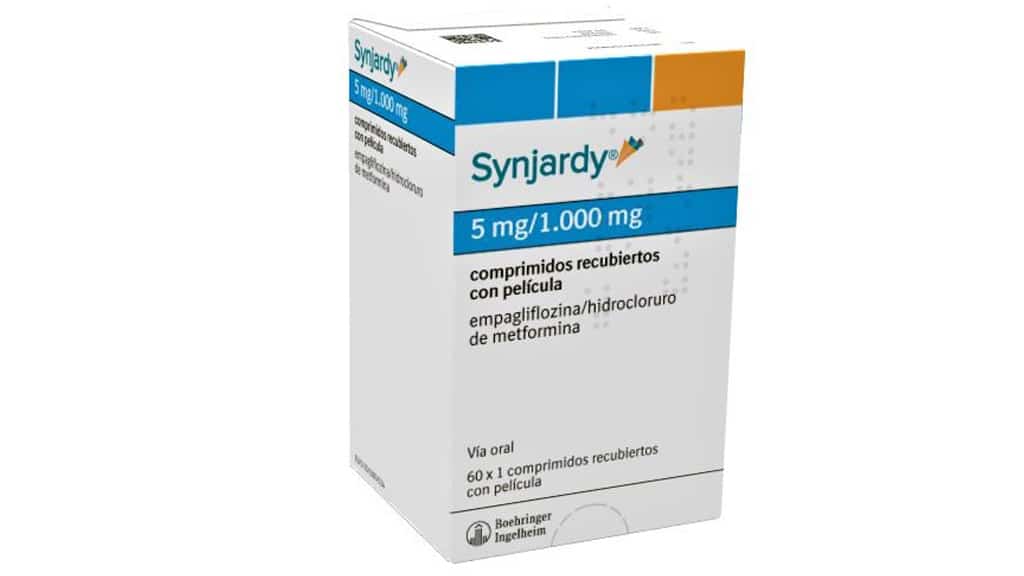What is Synjardy?
Synjardi uses. Synjardy is a prescription drug used to treat type 2 diabetes in adults. This FDA-approved medicine is used in tandem with proper diet and exercise. It is available under the generic name empagliflozin-metformin. Note that Synjardy is not meant for treating type 1 diabetes.
How does Synjardy work?
Synjardy works by controlling blood sugar levels in type 2 diabetes patients. It is a combination of two essential anti-diabetes agents – empagliflozin and metformin – also the name for the generic version of this drug.
Empagliflozin (Jardiance) is a type of sodium-glucose cotransporter-2 inhibitor. Its primary function is to help the kidney remove excess glucose from the bloodstream. It prevents glucose reabsorption in the kidney, lowering blood sugar levels.
Metformin (Fortamet, Glucophage) effectively lowers high blood sugar levels in type 2 diabetes patients. It is the only accessible Biguanide that prevents glucose production in the liver. This process makes the body more sensitive to insulin and reduces glucose accumulation entering the intestines.
The combination of empagliflozin and metformin boosts insulin sensitivity. It reverses the effects of type 2 diabetes and prevents the onset of diabetes complications, including:
- Kidney damage
- Blindness
- Nerve problems
- Loss of limbs
- Sexual dysfunction
- Heart attack or stroke
Precautions and warnings for taking Synjardy
Hypersensitivity can be fatal. It can lead to allergic reactions that worsen treatment, especially if you have diabetes. Avoid using Synjardy if you are allergic to it or its active ingredients. Additionally, this medicine can trigger lactic acidosis. The associated symptoms are nausea, vomiting, irregular heartbeat, difficulty breathing, and muscle spasms. If you experience any of these, report your condition at once.
Before using this medicine, your healthcare professional examines your medical history. This includes previous diagnoses of kidney and liver diseases, a bladder infection, and congestive heart failure. Once all is checked, you will receive a detailed prescription that includes your daily dosage with Synjardy.
Recommended daily dosage
Synjardy is available in different strengths. These are as follows:
- 5 mg Empagliflozin & 850 mg Metformin
- 5 mg Empagliflozin & 1,000 mg Metformin
- 12.5 mg Empagliflozin & 850 mg Metformin
- 12.5 mg Empagliflozin & 1,000 mg Metformin
For the starting dosage, the amount of Synjardy to take varies. It depends on the severity of the condition or if you are already taking any of the two compositions of this medicine. However, we have provided the standard dosage recommended for patients with type 2 diabetes.
- Take two doses of Synjardy twice each day with meals. The recommended amount is 10 mg or 25 mg of Empagliflozin. Meanwhile, the dosage for Metformin should be at most daily required use.
How to take Synjardy?
Follow the prescription provided by your healthcare professional. If you require additional instructions, a leaflet containing more detailed information about this medicine is available with the product.
Take Synjardy orally. As mentioned in the dosage, consume this medicine twice daily with meals. During your first week of treatment, your healthcare professional will prescribe lower doses to reduce the risk of side effects. You will gradually increase your dosage if your body can tolerate its effects.
Avoid skipping or missing a dose. However, if you miss one, take it as soon as you remember. Ensure that you do not take two doses at the same time. You can also set a reminder on your phone to notify you of your dosing schedule. It will also help you become more consistent with your treatment.
Side effects of taking Synjardy
We categorized the side effects of Synjardy as the most common and most severe. The list is as follows:
Common side effects:
- Upset stomach
- Nausea
- Vomiting
- Diarrhea
- Weakness
- Sore throat
- Dizziness
- Low blood sugar (hypoglycemia)
Severe side effects:
- Drowsiness
- Less urination
- Lightheadedness
- Confusion
- Difficulty breathing
- Fatigue
- Bloody urine
- Muscle pain
- Irregular heartbeat
- Bladder infection
Note: The common adverse reactions of Synjardy are manageable and less serious. However, if they persist for an extended period and severe side effects develop, contact your healthcare professional and ask for immediate medical care.
Doctor’s Recommendation
Take Synjardy as directed by your healthcare provider to manage type 2 diabetes. Follow these simple steps:
- Dosage: Take the medication orally, twice daily with meals.
- Starting Dose: Begin with the initial dosage to minimize side effects, gradually increasing as tolerated.
- Missed Dose: If you forget a dose, take it as soon as you remember unless it’s close to your next scheduled dose.
- Follow Directions: Do not adjust your dosage without consulting your doctor.
- Monitor Blood Sugar: Regularly check your blood sugar levels and report any significant changes or adverse effects to your healthcare provider.
By following these steps, Synjardy can effectively control your blood sugar levels while minimizing risks.



